Relative Importance of Climatic and Anthropogenic Drivers on the Dynamics of Aboveground Biomass across Agro-Ecological Zones on the Mongolian Plateau
Abstract
:1. Introduction
2. Materials and Methods
2.1. Study Area
2.2. Agro-Ecological Zoning on MP
- We calculated the areal proportions of different land covers within each soum and county based on the MODIS land cover product (2012) (Figure 1). Those divisions primarily covered by forest, gobi and desert were masked out from this study as these land covers play limited roles in livestock and grain production, which are the major human forces driving AGB dynamics on MP.
- We obtained an agricultural zoning map of IM from published official documents [11]. On this map, 101 counties in IM were classified into five agricultural zones (grazing, grazing-farming, farming, forestry and urban/built-up) on the basis of dominance of different sectors in local agriculture. In this study, only the grazing, grazing-farming and farming zones were retained for detailed analysis (Figure 2). For ML, as livestock grazing is the predominant agricultural activity throughout the whole country, we categorized the remaining soums as the grazing zone.
- Considering grassland AGB responds to climate variation differently along a precipitation gradient [23,37], we subdivided the grazing zones of ML and IM by the 250 mm isohyet: The subzone with relatively humid climate (>250 mm) was defined as the Grazing-H zone; correspondingly, the subzone with relatively arid climate (<250 mm) was defined as the Grazing-A zone (Table 1). This precipitation criterion is suggested by Ellis and Swift [40] and has been applied in several empirical studies on MP [7,23].
- We excluded those soums and counties with incomplete agricultural statistics from the study.
2.3. Conceptual Framework
2.4. Data Acquisition and Processing
2.4.1. VOD Dataset
2.4.2. Climatic Data
2.4.3. Agricultural Statistics
2.4.4. Non-Parametric Statistical Techniques
2.4.5. Spatial Panel Data Models
3. Results
3.1. Trends in AGB across Agro-Ecological Zones
3.2. Trends in Climatic Drivers and Their Correlations with AGB
3.3. Trends in Anthropogenic Drivers and Their Correlations with AGB
3.4. Estimates of the Spatial Panel Data Models for AGB Dynamics
4. Discussion
4.1. Relative Effects of Climatic and Anthropogenic Drivers on Grassland Degradation in ML
4.2. Relative Effects of Climatic and Anthropogenic Drivers on Grassland Restoration in IM
4.3. Relative Effects of Climatic and Anthropogenic Drivers on Agricultural Intensification in IM
4.4. Implications for Regional Sustainability
4.5. Limitations of This Study
5. Conclusions
- AGB declined in most parts of the grazing zone of ML during 1993–2012. The reduction of precipitation, the rise of temperature and the intensification of livestock grazing were the major drivers behind it. Ranked by their relative importance, the order in the grazing zone with relatively humid climate was: Precipitation ≈ temperature > livestock grazing; the order in the grazing zone with relatively arid climate was: Precipitation > temperature > livestock grazing.
- In the grazing zone of ML, the contribution of precipitation to the decline of AGB increased with aridity. By contrast, the contribution of livestock grazing to the decline of AGB increased with humidity.
- AGB increased in most parts of the grazing zone of IM since the implementation of ERPs in the early 2000s. The increase of precipitation was the dominant driver behind it. China’s ERPs contributed indirectly to the increase of AGB by diminishing the negative impact of livestock production on grasslands.
- In the grazing zone of IM, the contribution of precipitation to the increase of AGB increased with aridity.
- AGB increased in most parts of the grazing-farming zone of IM since the early 2000s. The increase of precipitation, the decline of temperature and the intensification of grain production were the major drivers behind it. Ranked by their relative importance, the order was: Precipitation > grain production > temperature.
- AGB increased in most parts of the farming zone of IM since the early 2000s. The increase of precipitation and the intensification of grain production were the major drivers behind it. Ranked by their relative importance, the order was: Grain production > precipitation.
Supplementary Materials
Author Contributions
Funding
Acknowledgments
Conflicts of Interest
References
- White, R.; Murray, S.; Rohweder, M. Pilot Analysis of Global Ecosystems (PAGE): Grassland Ecosystems; World Resources Institute (WRI): Washington, DC, USA, 2000; p. 100. [Google Scholar]
- Ma, A.; He, N.P.; Yu, G.R.; Wen, D.; Peng, S.L. Carbon storage in Chinese grassland ecosystems: Influence of different integrative methods. Sci. Rep. 2016, 6, 21378. [Google Scholar] [CrossRef] [PubMed] [Green Version]
- O’Mara, F.P. The role of grasslands in food security and climate change. Ann. Bot. 2012, 110, 1263–1270. [Google Scholar] [CrossRef] [PubMed] [Green Version]
- Kemp, D.R.; Han, G.D.; Hou, X.Y.; Michalk, D.L.; Hou, F.J.; Wu, J.P.; Zhang, Y.J. Innovative grassland management systems for environmental and livelihood benefits. Proc. Natl. Acad. Sci. USA 2013, 110, 8369–8374. [Google Scholar] [CrossRef] [PubMed] [Green Version]
- Ma, Z.Y.; Liu, H.Y.; Mi, Z.R.; Zhang, Z.H.; Wang, Y.H.; Xu, W.; Jiang, L.; He, J.S. Climate warming reduces the temporal stability of plant community biomass production. Nat. Commun. 2017, 8, 15378. [Google Scholar] [CrossRef] [PubMed] [Green Version]
- Lambin, E.F.; Geist, H.J.; Helmut, J. Land-Use and Land-Cover Change: Local Processes and Global Impacts; Springer: Berlin, Germany, 2006. [Google Scholar]
- Wang, J.; Brown, D.G.; Chen, J.Q. Drivers of the dynamics in net primary productivity across ecological zones on the Mongolian Plateau. Landsc. Ecol. 2013, 28, 725–739. [Google Scholar] [CrossRef]
- Chen, J.Q.; John, R.; Shao, C.L.; Fan, Y.; Zhang, Y.Q.; Amarjargal, A.; Brown, D.G.; Qi, J.G.; Han, J.J.; Lafortezza, R.; et al. Policy shifts influence the functional changes of the CNH systems on the Mongolian plateau. Environ. Res. Lett. 2015, 10, 085003. [Google Scholar] [CrossRef] [Green Version]
- Liu, Y.Y.; van Dijk, A.; de Jeu, R.A.M.; Canadell, J.G.; McCabe, M.F.; Evans, J.P.; Wang, G.J. Recent reversal in loss of global terrestrial biomass. Nat. Clim. Chang. 2015, 5, 470–474. [Google Scholar] [CrossRef]
- Yang, Y.H.; Fang, J.Y.; Pan, Y.D.; Ji, C.J. Aboveground biomass in Tibetan grasslands. J. Arid Environ. 2009, 73, 91–95. [Google Scholar] [CrossRef]
- Da, L.; Zheng, Y. True or false overgrazing? An empirical study in the Inner Mongolian grasslands. Chin. Rural Econ. 2012, 5, 4–18. [Google Scholar]
- Brinkmann, K.; Dickhoefer, U.; Schlecht, E.; Buerkert, A. Quantification of aboveground rangeland productivity and anthropogenic degradation on the Arabian Peninsula using Landsat imagery and field inventory data. Remote Sens. Environ. 2011, 115, 465–474. [Google Scholar] [CrossRef]
- Liu, Y.Y.; van Dijk, A.; McCabe, M.F.; Evans, J.P.; de Jeu, R.A.M. Global vegetation biomass change (1988-2008) and attribution to environmental and human drivers. Glob. Ecol. Biogeogr. 2013, 22, 692–705. [Google Scholar] [CrossRef]
- Andela, N.; Liu, Y.Y.; van Dijk, A.; de Jeu, R.A.M.; McVicar, T.R. Global changes in dryland vegetation dynamics (1988–2008) assessed by satellite remote sensing: Comparing a new passive microwave vegetation density record with reflective greenness data. Biogeosciences 2013, 10, 6657–6676. [Google Scholar] [CrossRef] [Green Version]
- Allington, G.R.H.; Li, W.; Brown, D.G. Urbanization and environmental policy effects on the future availability of grazing resources on the Mongolian Plateau: Modeling socio-environmental system dynamics. Environ. Sci. Policy 2017, 68, 35–46. [Google Scholar] [CrossRef]
- Miao, F.H.; Guo, Z.G.; Xue, R.; Wang, X.Z.; Shen, Y.Y. Effects of grazing and precipitation on herbage biomass, herbage nutritive value, and yak performance in an alpine meadow on the Qinghai-Tibetan Plateau. PLoS ONE 2015, 10. [Google Scholar] [CrossRef] [PubMed]
- Dieleman, W.I.J.; Vicca, S.; Dijkstra, F.A.; Hagedorn, F.; Hovenden, M.J.; Larsen, K.S.; Morgan, J.A.; Volder, A.; Beier, C.; Dukes, J.S.; et al. Simple additive effects are rare: A quantitative review of plant biomass and soil process responses to combined manipulations of CO2 and temperature. Glob. Chang. Biol. 2012, 18, 2681–2693. [Google Scholar] [CrossRef] [PubMed]
- Densmore-McCulloch, J.A.; Thompson, D.L.; Fraser, L.H. Short-term effects of changing precipitation patterns on shrub-steppe grasslands: Seasonal watering is more important than frequency of watering events. PLoS ONE 2016, 11. [Google Scholar] [CrossRef] [PubMed]
- Bloor, J.M.G.; Pichon, P.; Falcimagne, R.; Leadley, P.; Soussana, J.F. Effects of warming, summer drought, and CO2 enrichment on aboveground biomass production, flowering phenology, and community structure in an upland grassland ecosystem. Ecosystems 2010, 13, 888–900. [Google Scholar] [CrossRef]
- Ma, W.H.; Yang, Y.H.; He, J.S.; Hui, Z.; Fang, J.Y. Above- and belowground biomass in relation to environmental factors in temperate grasslands, Inner Mongolia. Sci. China Ser. C 2008, 51, 263–270. [Google Scholar] [CrossRef] [PubMed]
- Scurlock, J.M.O.; Johnson, K.; Olson, R.J. Estimating net primary productivity from grassland biomass dynamics measurements. Glob. Chang. Biol. 2002, 8, 736–753. [Google Scholar] [CrossRef] [Green Version]
- Li, W.; Cao, W.X.; Wang, J.L.; Li, X.L.; Xu, C.L.; Shi, S.L. Effects of grazing regime on vegetation structure, productivity, soil quality, carbon and nitrogen storage of alpine meadow on the Qinghai-Tibetan Plateau. Ecol. Eng. 2017, 98, 123–133. [Google Scholar] [CrossRef]
- Fernandez-Gimenez, M.E.; Allen-Diaz, B. Testing a non-equilibrium model of rangeland vegetation dynamics in Mongolia. J. Appl. Ecol. 1999, 36, 871–885. [Google Scholar] [CrossRef] [Green Version]
- Liu, J.H.; Wu, J.J.; Su, H.B.; Gao, Z.H.; Wu, Z.T. Effects of grazing exclusion in Xilin Gol grassland differ between regions. Ecol. Eng. 2017, 99, 271–281. [Google Scholar] [CrossRef]
- Liu, Y.Y.; Evans, J.P.; McCabe, M.F.; de Jeu, R.A.M.; van Dijk, A.; Dolman, A.J.; Saizen, I. Changing climate and overgrazing are decimating Mongolian steppes. PLoS ONE 2013, 8. [Google Scholar] [CrossRef] [PubMed]
- Chen, H.B.; Shao, L.Q.; Zhao, M.J.; Zhang, X.; Zhang, D.J. Grassland conservation programs, vegetation rehabilitation and spatial dependency in Inner Mongolia, China. Land Use Policy 2017, 64, 429–439. [Google Scholar] [CrossRef]
- John, R.; Chen, J.Q.; Kim, Y.; Ou-yang, Z.T.; Xiao, J.F.; Park, H.; Shao, C.L.; Zhang, Y.Q.; Amarjargal, A.; Batkhshig, O.; et al. Differentiating anthropogenic modification and precipitation-driven change on vegetation productivity on the Mongolian Plateau. Landsc. Ecol. 2016, 31, 547–566. [Google Scholar] [CrossRef]
- Wu, J.G.; Zhang, Q.; Li, A.; Liang, C.Z. Historical landscape dynamics of Inner Mongolia: Patterns, drivers, and impacts. Landsc. Ecol. 2015, 30, 1579–1598. [Google Scholar] [CrossRef]
- Zhao, X.; Hu, H.F.; Shen, H.H.; Zhou, D.J.; Zhou, L.M.; Myneni, R.B.; Fang, J.Y. Satellite-indicated long-term vegetation changes and their drivers on the Mongolian Plateau. Landsc. Ecol. 2015, 30, 1599–1611. [Google Scholar] [CrossRef]
- Jiang, L.G.; Yao, Z.J.; Huang, H.Q. Climate variability and change on the Mongolian Plateau: Historical variation and future predictions. Clim. Res. 2016, 67, 1–14. [Google Scholar] [CrossRef]
- Hilker, T.; Natsagdorj, E.; Waring, R.H.; Lyapustin, A.; Wang, Y.J. Satellite observed widespread decline in Mongolian grasslands largely due to overgrazing. Glob. Chang. Biol. 2014, 20, 418–428. [Google Scholar] [CrossRef] [PubMed]
- Wang, J.; Brown, D.G.; Agrawal, A. Climate adaptation, local institutions, and rural livelihoods: A comparative study of herder communities in Mongolia and Inner Mongolia, China. Glob. Environ. Chang.-Hum. Policy Dimens. 2013, 23, 1673–1683. [Google Scholar] [CrossRef]
- Lu, D.S. The potential and challenge of remote sensing-based biomass estimation. Int. J. Remote Sens. 2006, 27, 1297–1328. [Google Scholar] [CrossRef]
- Liu, Y.Y.; de Jeu, R.A.M.; McCabe, M.F.; Evans, J.P.; van Dijk, A. Global long-term passive microwave satellite-based retrievals of vegetation optical depth. Geophys. Res. Lett. 2011, 38. [Google Scholar] [CrossRef] [Green Version]
- Tian, F.; Brandt, M.; Liu, Y.Y.; Verger, A.; Tagesson, T.; Diouf, A.A.; Rasmussen, K.; Mbow, C.; Wang, Y.J.; Fensholt, R. Remote sensing of vegetation dynamics in drylands: Evaluating vegetation optical depth (VOD) using AVHRR NDVI and in situ green biomass data over West African Sahel. Remote Sens. Environ. 2016, 177, 265–276. [Google Scholar] [CrossRef] [Green Version]
- John, R.; Chen, J.Q.; Giannico, V.; Park, H.; Xiao, J.F.; Shirkey, G.; Ouyang, Z.T.; Shao, C.L.; Lafortezza, R.; Qi, J.G. Grassland canopy cover and aboveground biomass in Mongolia and Inner Mongolia: Spatiotemporal estimates and controlling factors. Remote Sens. Environ. 2018, 213, 34–48. [Google Scholar] [CrossRef]
- Bai, Y.F.; Wu, J.G.; Xing, Q.; Pan, Q.M.; Huang, J.H.; Yang, D.L.; Han, X.G. Primary production and rain use efficiency across a precipitation gradient on the Mongolia plateau. Ecology 2008, 89, 2140–2153. [Google Scholar] [CrossRef] [PubMed]
- FAO. Agro-Ecological Zoning Guidelines; Food and Agriculture Organization of the United Nations: Roma, Italy, 1996. [Google Scholar]
- Fischer, G.; Shah, M.; Tubiello, F.N.; van Velhuizen, H. Socio-economic and climate change impacts on agriculture: An integrated assessment, 1990–2080. Philos. Trans. R. Soc. B-Biol. Sci. 2005, 360, 2067–2083. [Google Scholar] [CrossRef] [PubMed] [Green Version]
- Ellis, J.; Swift, D. Stability of African postoral ecosystems: Alternate paradigms and implications for development. J. Range Manag. 1988, 41, 450–459. [Google Scholar] [CrossRef]
- Jones, M.O.; Jones, L.A.; Kimball, J.S.; McDonald, K.C. Satellite passive microwave remote sensing for monitoring global land surface phenology. Remote Sens. Environ. 2011, 115, 1102–1114. [Google Scholar] [CrossRef]
- Owe, M.; de Jeu, R.; Walker, J. A methodology for surface soil moisture and vegetation optical depth retrieval using the microwave polarization difference index. IEEE Trans. Geosci. Remote Sens. 2001, 39, 1643–1654. [Google Scholar] [CrossRef] [Green Version]
- Li, A.; Wu, J.G.; Huang, J.H. Distinguishing between human-induced and climate-driven vegetation changes: A critical application of RESTREND in inner Mongolia. Landsc. Ecol. 2012, 27, 969–982. [Google Scholar] [CrossRef]
- Hamed, K.H. Trend detection in hydrologic data: The Mann-Kendall trend test under the scaling hypothesis. J. Hydrol. 2008, 349, 350–363. [Google Scholar] [CrossRef]
- Yue, S.; Pilon, P.; Cavadias, G. Power of the Mann-Kendall and Spearman’s rho tests for detecting monotonic trends in hydrological series. J. Hydrol. 2002, 259, 254–271. [Google Scholar] [CrossRef]
- Gocic, M.; Trajkovic, S. Analysis of precipitation and drought data in Serbia over the period 1980–2010. J. Hydrol. 2013, 494, 32–42. [Google Scholar] [CrossRef]
- McDonald, J.H. Handbook of Biological Statistics, 3rd ed.; Sparky House Publishing: Baltimore, MD, USA, 2014; p. 210. [Google Scholar]
- Elhorst, J.P. Spatial Econometrics: From Cross-Sectional Data to Spatial Panels; Springer: Heidelberg/Berlin, Germany, 2014. [Google Scholar]
- Elhorst, J.P. Specification and estimation of spatial panel data models. Int. Reg. Sci. Rev. 2003, 26, 244–268. [Google Scholar] [CrossRef]
- Hsiao, C. Panel data analysis—Advantages and challenges. Test-Spain 2007, 16, 1–22. [Google Scholar] [CrossRef]
- Elhorst, J.P. Spatial panel data models. In Handbook of Applied Spatial Analysis: Software Tools, Methods and Applications; Fischer, M.M., Getis, A., Eds.; Springer: Berlin, Germany, 2010; pp. 377–407. [Google Scholar]
- Elhorst, J.P. Spatial panel data analysis. In Encyclopedia of GIS, 2nd ed.; Shekhar, S., Xiong, H., ZHou, X., Eds.; Springer International Publishing: Cham, Switzerland, 2017; pp. 2050–2058. [Google Scholar]
- Deng, X.Z.; Huang, J.K.; Rozelle, S.; Uchida, E. Growth, population and industrialization, and urban land expansion of China. J. Urban Econ. 2008, 63, 96–115. [Google Scholar] [CrossRef]
- Auffhammer, M.; Carson, R.T. Forecasting the path of China’s CO2 emissions using province-level information. J. Environ. Econ. Manag. 2008, 55, 229–247. [Google Scholar] [CrossRef]
- Rodriguez-Pose, A.; Tselios, V. Education and income inequality in the regions of the European Union. J. Reg. Sci. 2009, 49, 411–437. [Google Scholar] [CrossRef]
- Zhang, Z.H.; Su, S.L.; Xiao, R.; Jiang, D.W.; Wu, J.P. Identifying determinants of urban growth from a multi-scale perspective: A case study of the urban agglomeration around Hangzhou Bay, China. Appl. Geogr. 2013, 45, 193–202. [Google Scholar] [CrossRef]
- Xu, J. Mathematical Methods in Contemporary Geography; Higher Education Press: Beijing, China, 2002. [Google Scholar]
- Belotti, F.; Hughes, G.; Mortari, A.P. Spatial panel-data models using Stata. Stata J. 2017, 17, 139–180. [Google Scholar] [CrossRef]
- Piao, S.L.; Mohammat, A.; Fang, J.Y.; Cai, Q.; Feng, J.M. NDVI-based increase in growth of temperate grasslands and its responses to climate changes in China. Glob. Environ. Chang.-Hum. Policy Dimens. 2006, 16, 340–348. [Google Scholar] [CrossRef]
- Nemani, R.R.; Keeling, C.D.; Hashimoto, H.; Jolly, W.M.; Piper, S.C.; Tucker, C.J.; Myneni, R.B.; Running, S.W. Climate-driven increases in global terrestrial net primary production from 1982 to 1999. Science 2003, 300, 1560–1563. [Google Scholar] [CrossRef] [PubMed]
- Okayasu, T.; Okuro, T.; Jamsran, U.; Takeuchi, K. Threshold distinctions between equilibrium and nonequilibrium pastoral systems along a continuous climatic gradient. Rangel. Ecol. Manag. 2011, 64, 10–17. [Google Scholar] [CrossRef]
- Hao, L.; Sun, G.; Liu, Y.Q.; Gao, Z.Q.; He, J.J.; Shi, T.T.; Wu, B.J. Effects of precipitation on grassland ecosystem restoration under grazing exclusion in Inner Mongolia, China. Landsc. Ecol. 2014, 29, 1657–1673. [Google Scholar] [CrossRef]
- Tian, H.J.; Cao, C.X.; Chen, W.; Bao, S.N.; Yang, B.; Myneni, R.B. Response of vegetation activity dynamic to climatic change and ecological restoration programs in Inner Mongolia from 2000 to 2012. Ecol. Eng. 2015, 82, 276–289. [Google Scholar] [CrossRef]
- Zhuo, L.; Cao, X.; Chen, J.; Chen, Z.; Shi, P. Assessment of grassland ecological restoration project in Xilingol Grassland. Acta Geogr. Sin. 2007, 62, 471–480. [Google Scholar]
- Fang, J.Y.; Piao, S.L.; Zhou, L.M.; He, J.S.; Wei, F.Y.; Myneni, R.B.; Tucker, C.J.; Tan, K. Precipitation patterns alter growth of temperate vegetation. Geophys. Res. Lett. 2005, 32, L21411. [Google Scholar] [CrossRef]
- Asian Development Bank (ADB). Making Grasslands Sustainable in Mongolia: Adapting to Climate and Environmental Change; Asian Development Bank (ADB): Mandaluyong, Philippines, 2013; p. 8. [Google Scholar]
- Intergovernmental Panel on Climate Change (IPCC). Climate Change 2014: Impacts, Adaptation, and Vulnerability. Part A: Global and Sectoral Aspects. Contribution of Working Group II to the Fifth Assessment Report of the Intergovernmental Panel on Climate Change; Cambridge University Press: Cambridge, UK, 2014; p. 1132. [Google Scholar]
- National Statistics Office of Mongolia (NSOM). Mongilian Statistical Yearbook 2017; National Statistics Office of Mongolia (NSOM): Ulaanbaatar, Mongolia, 2017. [Google Scholar]
- Qi, Y.C.; Dong, Y.S.; Peng, Q.; Xiao, S.S.; He, Y.T.; Liu, X.C.; Sun, L.J.; Jia, J.Q.; Yang, Z.J. Effects of a conversion from grassland to cropland on the different soil organic carbon fractions in Inner Mongolia, China. J. Geogr. Sci. 2012, 22, 315–328. [Google Scholar] [CrossRef] [Green Version]
- Jiao, Y.; Xu, Z.; Zhao, J. Effects of grassland conversion to cropland and forest on soil organic carbon and dissolved organic carbon in the farming-pastoral ecotone of Inner Mongolia. Acta Ecol. Sin. 2009, 29, 150–154. [Google Scholar] [CrossRef]
- Ó Dochartaigh, B.E.; MacDonald, A.M.; Darling, W.G.; Hughes, A.G.; Li, J.X.; Shi, L.A. Determining groundwater degradation from irrigation in desert-marginal northern China. Hydrogeol. J. 2010, 18, 1939–1952. [Google Scholar] [CrossRef] [Green Version]
- Jia, X.; Gao, Y.; Qi, H.G.J.; Wei, B.C.; Cui, X.X.; Meng, Z.J.; Tang, G.D. MODIS-based spatio-temporal distribution of wildfire in Inner Mongolia. Chin. J. Eco-Agric. 2017, 25, 127–135. [Google Scholar]
- Park, H.; Fan, P.; John, R.; Chen, J. Urbanization on the Mongolian Plateau after economic reform: Changes and causes. Appl. Geogr. 2017, 86, 118–127. [Google Scholar] [CrossRef]
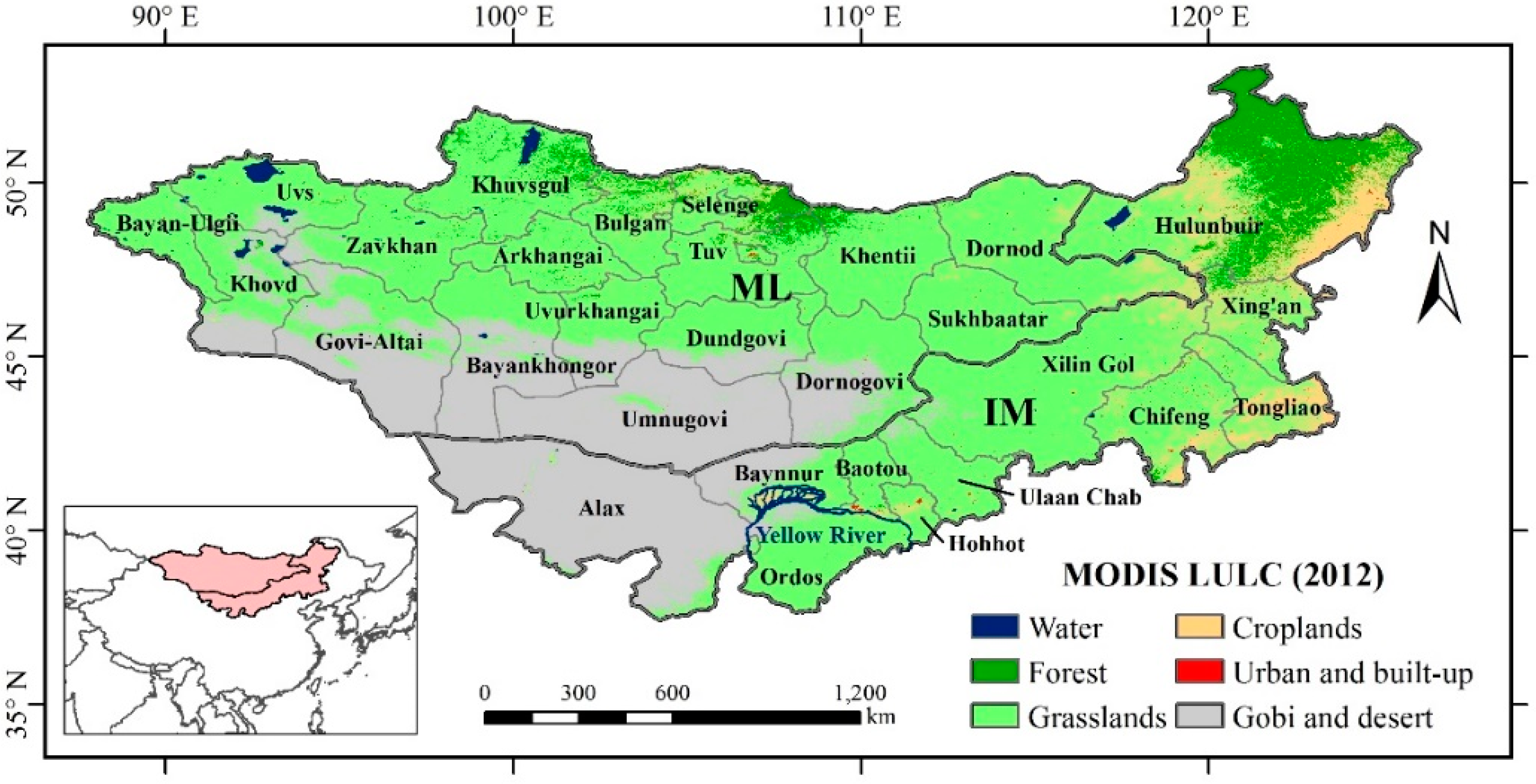
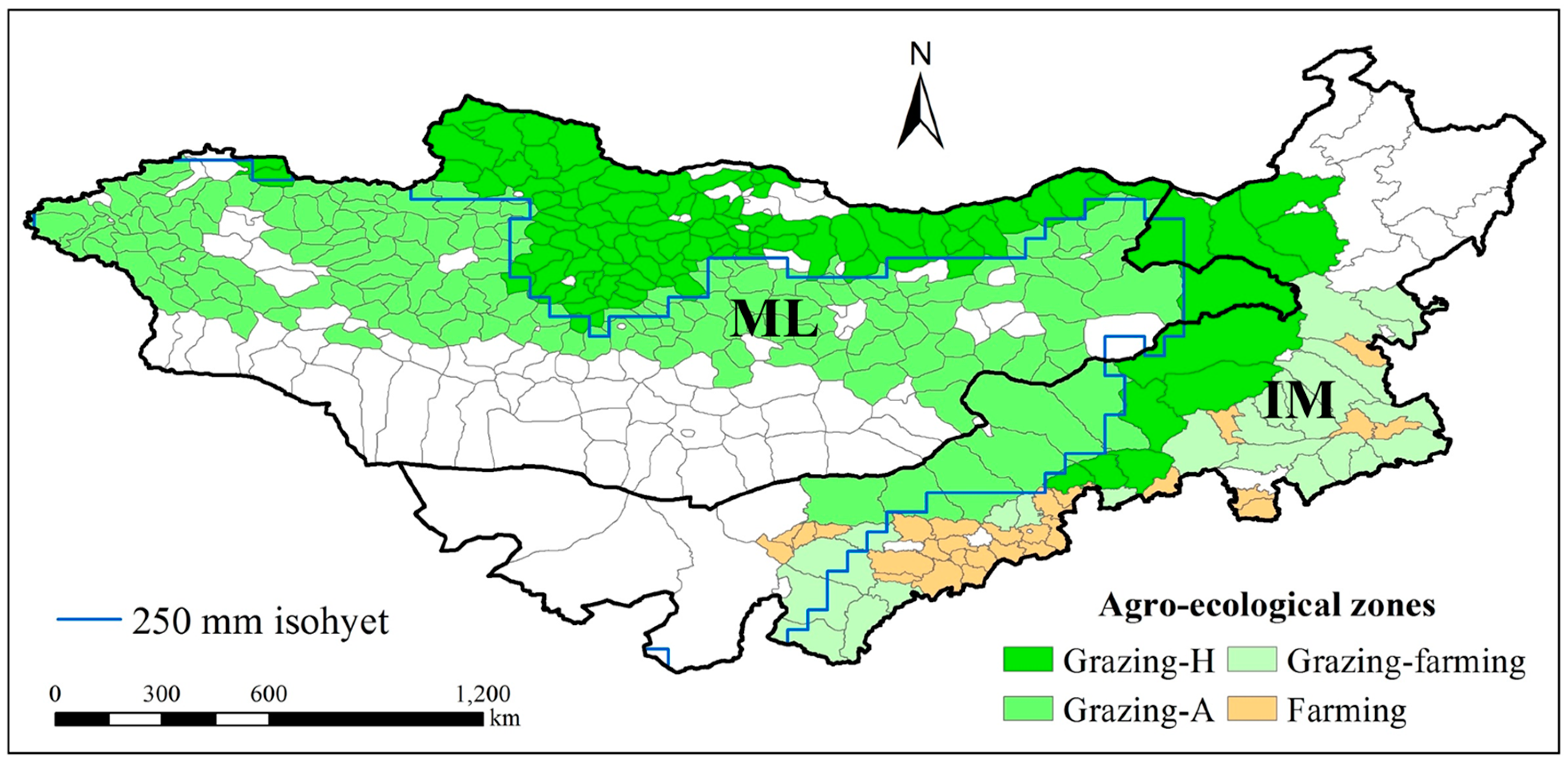
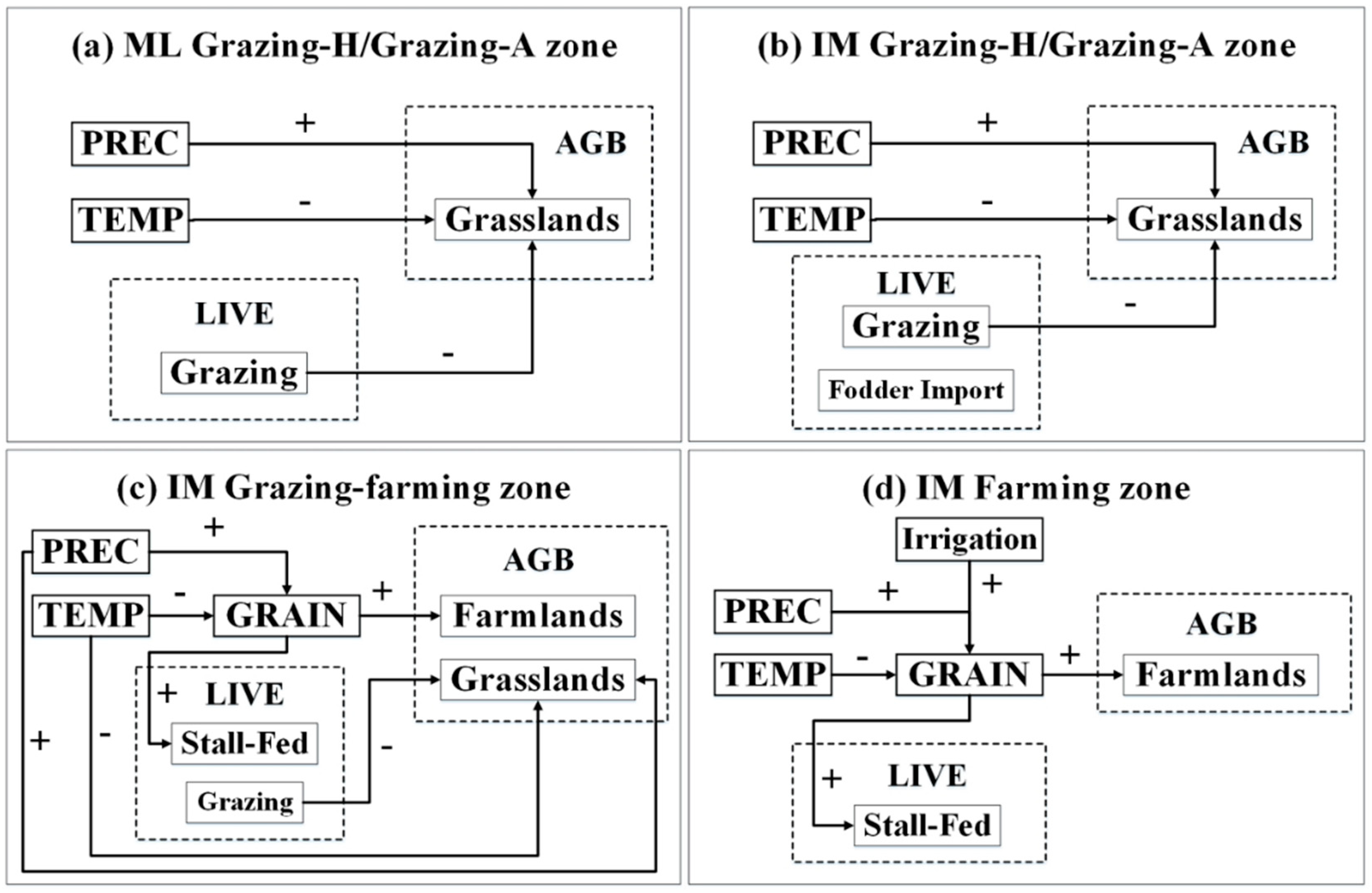




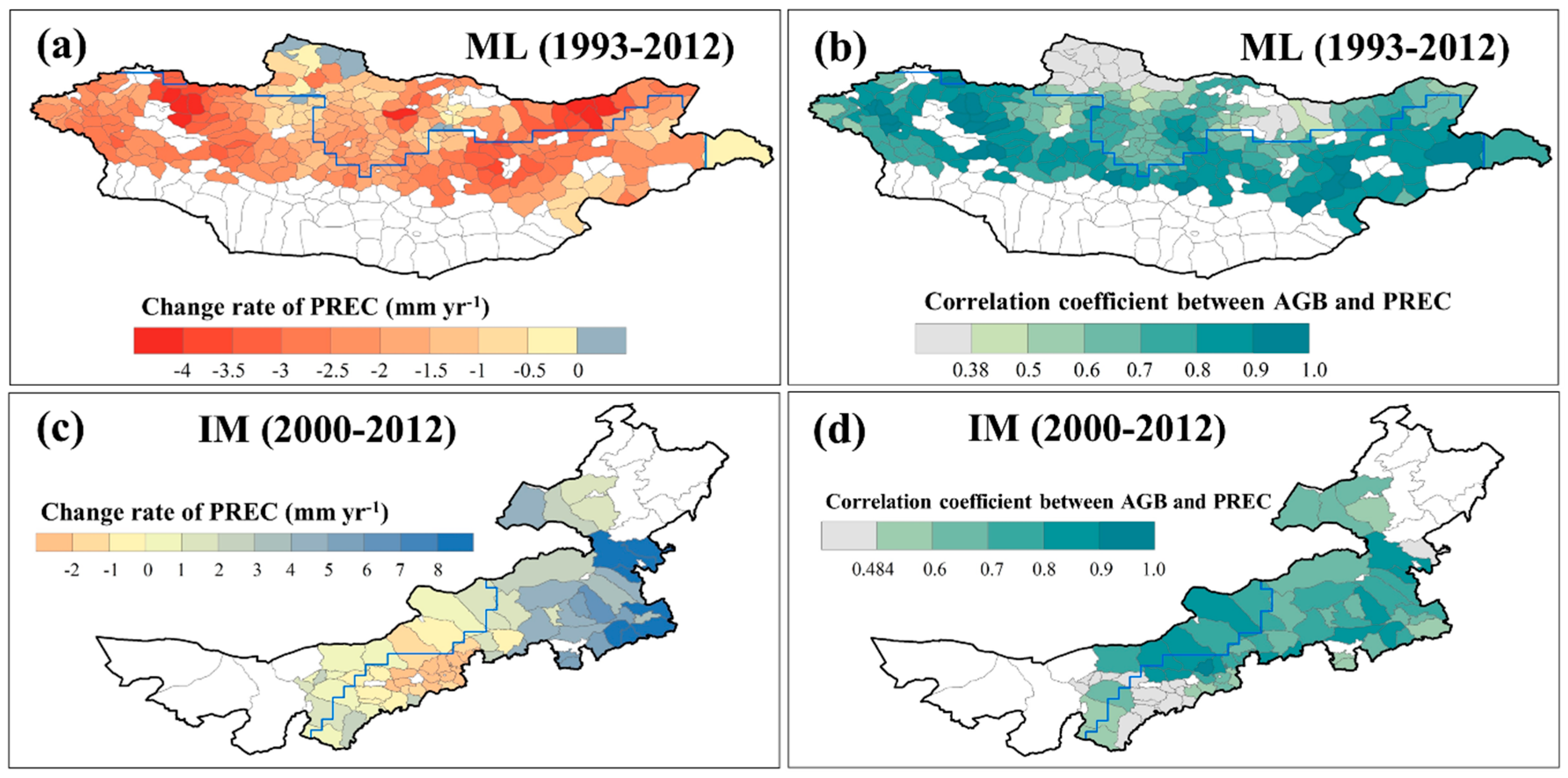
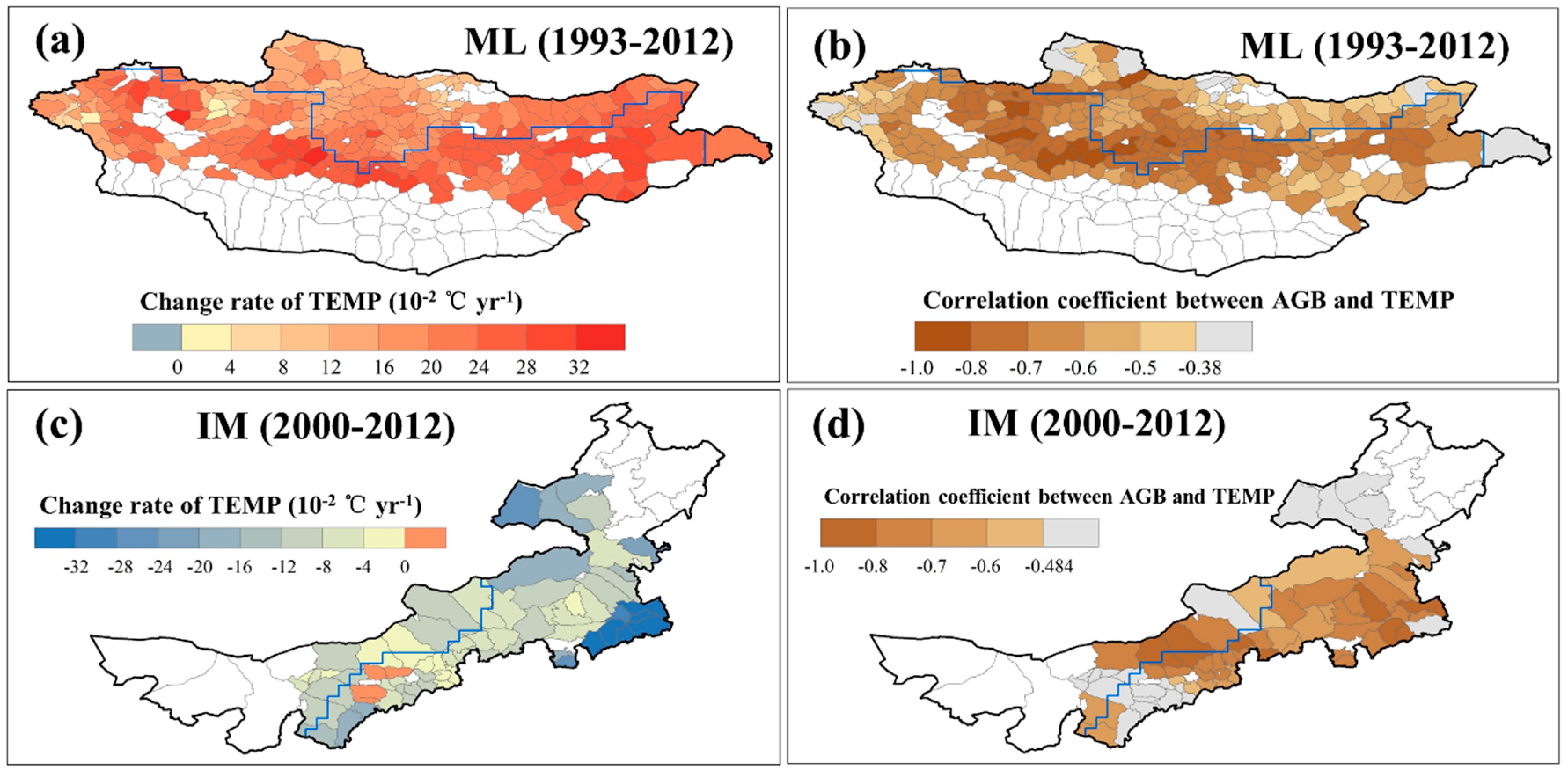



| Region | Agro-Ecological Zone | Number of Soums/Counties | Total Area (thousand km2) |
|---|---|---|---|
| ML | Grazing-H | 87 | 342.44 |
| Grazing-A | 153 | 640.75 | |
| IM | Grazing-H | 10 | 188.20 |
| Grazing-A | 6 | 152.75 | |
| Grazing-farming | 23 | 253.07 | |
| Farming | 28 | 100.57 |
| Variable | Definition | Unit |
|---|---|---|
| AGB | Annual maximum green aboveground biomass | Null |
| PREC | Optimal cumulative precipitation | mm |
| TEMP | Optimal cumulative temperature | °C |
| LIVE | Livestock densities | heads km−2 |
| GRAIN | Grain yields per unit area | tons km−2 |
| SPATIAL (δ) | Spatial autoregressive term | Null |
| AGB Trend (10−3 yr−1) | ML (1993–2012) | IM (2000–2012) | |||||
|---|---|---|---|---|---|---|---|
| Grazing-H | Grazing-A | Grazing-H | Grazing-A | Grazing-Farming | Farming | ||
| Decrease | Dramatic (<−8) | 16.8 | 11.1 | 0.0 | 0.0 | 0.0 | 0.0 |
| Moderate (−8~−4) | 39.4 | 30.0 | 3.4 | 0.0 | 0.2 | 2.4 | |
| Slight (−4~0) | 37.0 | 58.3 | 29.0 | 4.7 | 7.9 | 19.0 | |
| Increase | Slight (0~4) | 6.8 | 0.7 | 61.5 | 83.5 | 44.5 | 44.0 |
| Moderate (4~8) | 0.0 | 0.0 | 6.2 | 11.8 | 38.2 | 28.0 | |
| Dramatic (>8) | 0.0 | 0.0 | 0.0 | 0.0 | 9.4 | 6.7 | |
| Variable | ML (1993–2012) | IM (2000–2012) | ||||
|---|---|---|---|---|---|---|
| Grazing-H | Grazing-A | Grazing-H | Grazing-A | Grazing-Farming | Farming | |
| PREC | 0.1631 ** | 0.3012 ** | 0.3255 ** | 0.4374 ** | 0.1924 ** | 0.1304 ** |
| TEMP | −0.1194 ** | −0.0645 ** | −0.0400 | −0.0922 | −0.1690 ** | −0.0205 |
| LIVE | −0.0718 ** | −0.0190 * | −0.0327 | −0.0104 | −0.0043 | |
| GRAIN | 0.2616 ** | 0.3576 ** | ||||
| SPATIAL | 0.9619 ** | 0.9188 ** | 0.7753 ** | 0.5545 ** | 0.6355 ** | 0.8999 ** |
| Overall R2 | 0.5637 | 0.6418 | 0.4567 | 0.7715 | 0.5713 | 0.4306 |
| Variable | ML (1993–2012) | IM (2000–2012) | ||||
|---|---|---|---|---|---|---|
| Grazing-H | Grazing-A | Grazing-H | Grazing-A | Grazing-Farming | Farming | |
| PREC | 0.2791 | 0.5723 | 0.4476 | 0.7630 | 0.3847 | 0.1630 |
| TEMP | 0.2788 | 0.3000 | 0.2549 | |||
| LIVE | 0.1143 | 0.0481 | ||||
| GRAIN | 0.3412 | 0.3459 | ||||
| Overall | 0.5637 | 0.6418 | 0.4567 | 0.7715 | 0.5713 | 0.4306 |
© 2018 by the authors. Licensee MDPI, Basel, Switzerland. This article is an open access article distributed under the terms and conditions of the Creative Commons Attribution (CC BY) license (http://creativecommons.org/licenses/by/4.0/).
Share and Cite
Zhou, X.; Yamaguchi, Y. Relative Importance of Climatic and Anthropogenic Drivers on the Dynamics of Aboveground Biomass across Agro-Ecological Zones on the Mongolian Plateau. Sustainability 2018, 10, 3435. https://doi.org/10.3390/su10103435
Zhou X, Yamaguchi Y. Relative Importance of Climatic and Anthropogenic Drivers on the Dynamics of Aboveground Biomass across Agro-Ecological Zones on the Mongolian Plateau. Sustainability. 2018; 10(10):3435. https://doi.org/10.3390/su10103435
Chicago/Turabian StyleZhou, Xiang, and Yasushi Yamaguchi. 2018. "Relative Importance of Climatic and Anthropogenic Drivers on the Dynamics of Aboveground Biomass across Agro-Ecological Zones on the Mongolian Plateau" Sustainability 10, no. 10: 3435. https://doi.org/10.3390/su10103435






